Mahlon Blaine :: 1894-1969
Mahlon Blaine’s best work walked the razor's edge between
the grotesque and beautiful. Though few facts of his life are verifiable,
insomuch as anyone can gather, he lived in that no man’s land as well.
A childhood accident left the artist – who was born in 1894 - blind in
his left eye, an accident that contributes to the flattened perspective
that marks his work. Though he alleged to have seen combat in World War
I, the Army rarely drafted the half blind. A well-documented chronic injury
to his left arm was unlikely to have come from a war wound. The plate in
his head of which he boasted was probably fictional. Few photographs of
the artist survive, but his self-portraits further the likely fake war
hero persona.
In 1928, Blaine depicted himself as a typical, pipe-smoking
veteran from the Lost Generation, an archetype that could be mistaken for
a Hemingway dust jacket. After the war years, Blaine led a transient existence,
toiling in Hollywood in the era of avant-garde silent films, and bouncing
back and forth from the West Coast to New York City as his marriage to
b-movie actress Duskal Blaine smoldered, exploded, and then reignited.
According to his own count, Blaine and his wife married
and divorced no fewer than three times. But of course, Blaine’s count is
not to be trusted. Though he was beloved by his friends for his poetic
approach to life—-his storytelling style was once compared to haiku, containing
just a glimmer of meaning for the listener to deduce—-his life is best
pieced back together by tracking his career. For decades Blaine labored
in the factory-like setting of the underground New York erotic literature
scene. Working closely with Jack Brussel, the energetic antiquarian book
dealer who published and sold erotica first at his Ortelius Book Shop and
then at other Fourth Avenue locations, Blaine illustrated symbolist classics
like Paul Verlaine’s Hashish and Incense, the Marquis de Sade’s Justine,
fast-money low-market fetish pornographic booklets, and everything in between.
Befriending a young John Steinbeck in the early 1920s, Blaine illustrated
the book jacket of Steinbeck's first novel Cup of Gold.
The apocryphal story of the meeting between Steinbeck
and Blaine finds the two men on the Panama Canal. Steinbeck, a recent college
graduate was moving from Canada to Greenwich Village to try his luck as
a writer. "Standing at the railing, John remarked spontaneously to the
passenger next to him: "Isn't 'Iowa by the Sea' beautiful?" To which Blaine
replied-- "My God, you speak English!"- amazed to find an English speaker
(with a clever sense of humor) amidst the mostly immigrant crew. On arriving
in New York, they lived on different floors at the Parkwood Hotel and explored
the city together. Blaine was impressed with some of John's stories and
introduced him to an editor he worked with at Robert McBride & Co.,
the eventual publishers of Cup of Gold. Blaine would subsequently design
the dust jackets and endpapers for both Cup of Gold and To a God Unknown."
Though Steinbeck's star would keep rising throughout his
career, Blaine increasingly struggled for respectable work in the 1930s.
Unlike many of the illustrators who were sweating it out uptown for the
pulps and refusing to sign their names to their completed creations, Blaine
took pride in his Aubrey Beardsley-derived yet wildly original, groundbreaking
and explicit artworks. He would work steadily in this genre until the end
of his career in the 1960s, accepting commissions for freelance work from
clients as diverse as Arizona Highways Magazine and Edgar Rice Burroughs’
The Land the Time Forgot. Blacklisted from the ranks of working illustrators
for his work as a pornographer, Blaine began using the pseudonym G. Christopher
Hudson for some of his more mainstream endeavors.
Blaine’s devotion to the macabre, the bizarre, and the
sexual aspects of his art put the brakes on his commercial career. Though,
patrons bought his original works during his lifetime, his cult status
today emerged only through his rediscovery by sci-fi collectors and underground
cartoonists. Still, Blaine’s admirers during his lifetime were fierce.
Along with magician Joseph Dunninger, who literally kept Blaine fed during
lean times (often complaining about the artist's prodigious appetite),
Blaine gathered fans in the elite of New York City's design world.
In the late 1930s, Blaine began work on one of his most
ambitious projects. With the noted interior designer Paul Ritter MacAlister,
Blaine created a series of ten mural concept paintings for MacAlister’s
proposed New York City showroom. The final murals, with images featuring
haunting and surreal takes on the hyper-sexualized and industrial machine-age
culture of modernist Manhattan, were never executed. The concept paintings
feature giantesses in coitus with skyscrapers, and nudes on "gadgets" invented
with obsessional detail. These are some of the most realized color artworks
that have emerged by the artist to date. It’s hard to imagine that even
Blaine could foresee these images becoming part of the midtown Manhattan
urban cityscape. Certainly MacAlister - who would later go on to become
a TV personality in Chicago with the first precursor to today’s HGTV programming
– never did. However, the project gained at least some traction, and MacAlister
created a 1:12 miniature room with his rough tempura sketches of the Blaine's
proposed murals seen throughout.
How much of Blaine’s obscurity in his lifetime came from
his emergence during the depression years, when high end glossy work was
scarce, and how much was due to a form of self-sabotage may never be entirely
clear. Haunted by his own demons, Blaine spent the early 1940s under the
psychiatric care of Greystone Hospital’s Dr. Archie Crandall. This period
(coming directly after the completion of his work for MacAlister) marks
the only known break in Blaine’s working life. After ironically completing
illustrations for a reissue of E. Thelmar’s 1909 autobiography of madness
The Maniac, Blaine slipped out of public view, before returning to the
New York art scene in the 1950s.
His last significant contract would come in 1962, when
the early fantasy & science fiction publishing house Canaveral Press
hired Blaine to illustrate their reprints of the works of Edgar Rice Burroughs.
At the time, Blaine was living over the small bookshop out of which the
publishing house was run, and considered an elder statesman in the world
of specialty publishing. Though by the 60s, Blaine was in fact elderly,
his work remained before its time. Though Blaine's illustration's for the
Burroughs's line are far from his most technically proficient, the series
represented a turning away from the heroic, literal-minded approach to
book illustration. The images were widely disparaged at the time but they
introduced a generation of artists and cartoonists to Blaine’s genius.
His influence on the underground cartoonists of the 1970s is powerful,
with visionaries like Robert Crumb and Art Spiegelman referencing his work.
No one, least of all Blaine, ever sorted out fact from
fiction regarding his life story, but that doesn't matter. Blaine emobodied
the myth of the artist throughout his dynamic career. Mahlon Blaine died
in poverty and obscurity in 1969.
Reference:



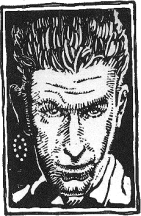
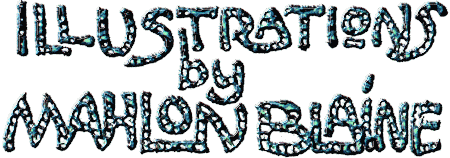
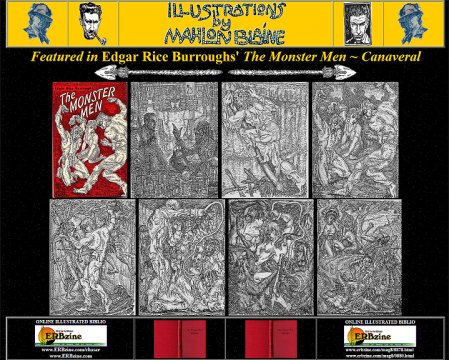 .
.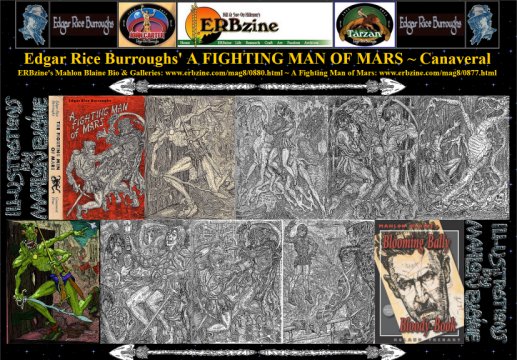
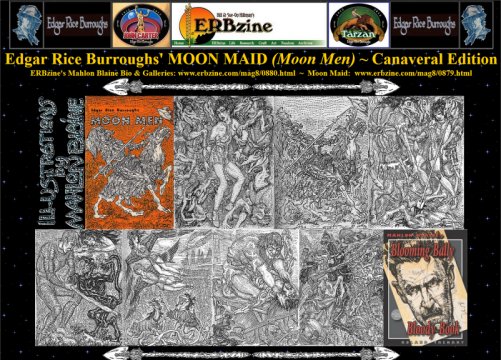 .
.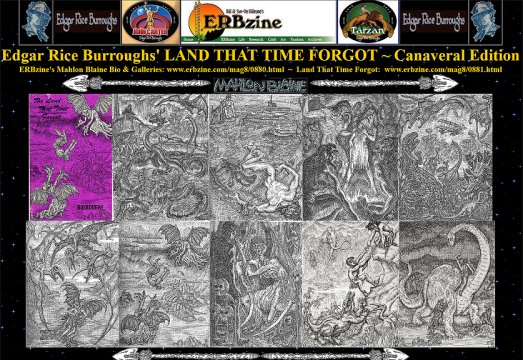
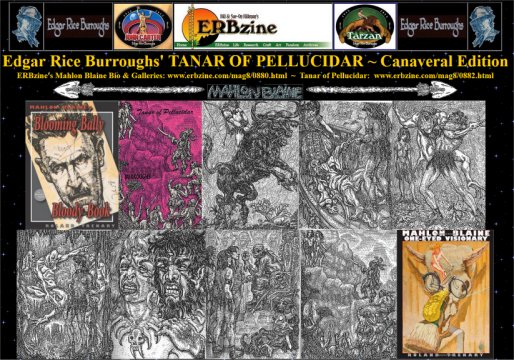 .
.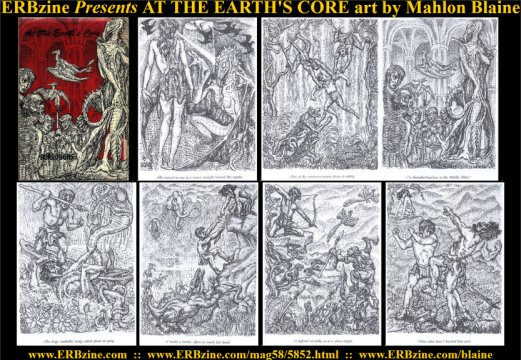
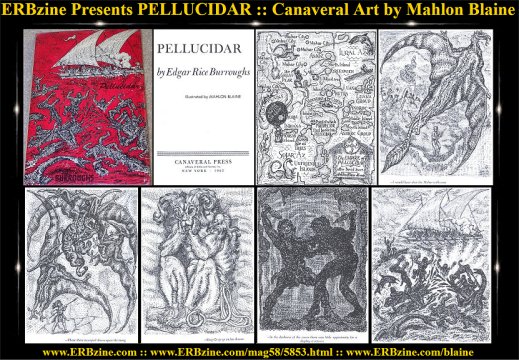


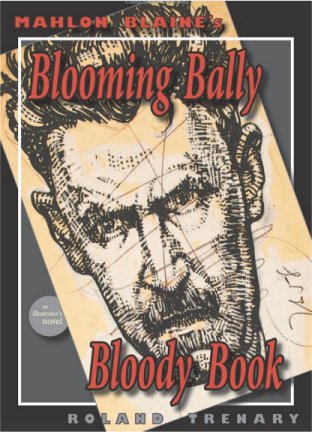 .
.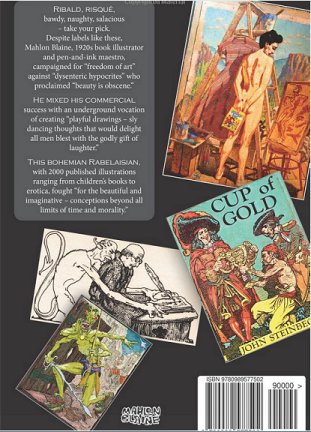



![]()

![]()